
A sporangium, is an enclosure in which spores are formed. It can be composed of a single cell or can be multicellular. Virtually all plants, fungi, and many other lineages form sporangia at some point in their life cycle. Sporangia can produce spores by mitosis, but in nearly all land plants and many fungi, sporangia are the site of meiosis and produce genetically distinct haploid spores.

Lycopodiopsida is a class of vascular plants known as lycopods, lycophytes or other terms including the component lyco-. Members of the class are also called clubmosses, firmosses, spikemosses and quillworts. They have dichotomously branching stems bearing simple leaves called microphylls and reproduce by means of spores borne in sporangia on the sides of the stems at the bases of the leaves. Although living species are small, during the Carboniferous, extinct tree-like forms (Lepidodendrales) formed huge forests that dominated the landscape and contributed to coal deposits.

Selaginella is the sole genus in the family Selaginellaceae, the spikemosses or lesser clubmosses, a kind of vascular plant.

Isoetes, commonly known as the quillworts, is a genus of lycopod. It is the only living genus in the family Isoetaceae and order Isoetales. There are currently 192 recognized species, with a cosmopolitan distribution mostly in aquatic habitats but with the individual species often scarce to rare. Some botanists split the genus, separating two South American species into the genus Stylites, although molecular data place these species among other species of Isoetes, so that Stylites does not warrant taxonomic recognition. Species virtually identical to modern quillworts have existed since the Jurassic epoch, though the timing of the origin of modern Isoetes is subject to considerable uncertainty.

The Lycopodiaceae are an old family of vascular plants, including all of the core clubmosses and firmosses, comprising 16 accepted genera and about 400 known species. This family originated about 380 million years ago in the early Devonian, though the diversity within the family has been much more recent. "Wolf foot" is another common name for this family due to the resemblance of either the roots or branch tips to a wolf's paw.

Lycopodium is a genus of clubmosses, also known as ground pines or creeping cedars, in the family Lycopodiaceae. Two very different circumscriptions of the genus are in use. In the Pteridophyte Phylogeny Group classification of 2016, Lycopodium is one of nine genera in the subfamily Lycopodioideae, and has from nine to 15 species. In other classifications, the genus is equivalent to the whole of the subfamily, since it includes all of the other genera. More than 40 species are accepted.
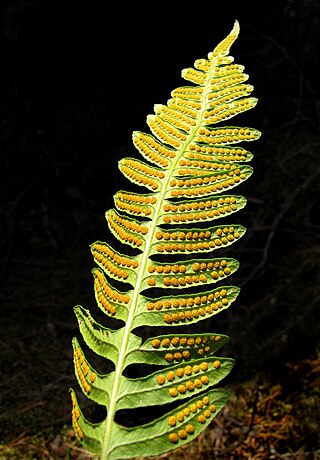
A sporophyll is a leaf that bears sporangia. Both microphylls and megaphylls can be sporophylls. In heterosporous plants, sporophylls bear either megasporangia and thus are called megasporophylls, or microsporangia and are called microsporophylls. The overlap of the prefixes and roots makes these terms a particularly confusing subset of botanical nomenclature.

Lycopodium clavatum is the most widespread species in the genus Lycopodium in the clubmoss family.

Lycopodiella is a genus in the clubmoss family Lycopodiaceae. The genus members are commonly called bog clubmosses, describing their wetland habitat. The genus has a cosmopolitan distribution, with centers of diversity in the tropical New World and New Guinea. In the past, the genus was often incorporated within the related genus Lycopodium, but was segregated in 1964. In the Pteridophyte Phylogeny Group classification of 2016, Lycopodiella is placed in the subfamily Lycopodielloideae, along with three other genera. In this circumscription, the genus has about 15 species. Other sources use a wider circumscription, in which the genus is equivalent to the Lycopodielloideae of PPG I, in which case about 40 species and hybrids are accepted.
A strobilus is a structure present on many land plant species consisting of sporangia-bearing structures densely aggregated along a stem. Strobili are often called cones, but some botanists restrict the use of the term cone to the woody seed strobili of conifers. Strobili are characterized by a central axis surrounded by spirally arranged or decussate structures that may be modified leaves or modified stems.
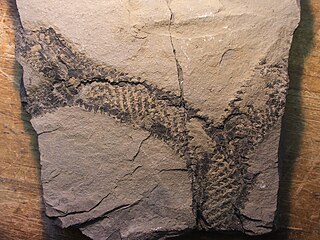
Lepidodendrales or arborescent lycophytes are an extinct order of primitive, vascular, heterosporous, arborescent (tree-like) plants belonging to Lycopodiopsida. Members of Lepidodendrales are the best understood of the fossil lycopsids due to the vast diversity of Lepidodendrales specimens and the diversity in which they were preserved; the extensive distribution of Lepidodendrales specimens as well as their well-preservedness lends paleobotanists exceptionally detailed knowledge of the coal-swamp giants’ reproductive biology, vegetative development, and role in their paleoecosystem. The defining characteristics of the Lepidodendrales are their secondary xylem, extensive periderm development, three-zoned cortex, rootlike appendages known as stigmarian rootlets arranged in a spiralling pattern, and megasporangium each containing a single functional megaspore that germinates inside the sporangium. Many of these different plant organs have been assigned both generic and specific names as relatively few have been found organically attached to each other. Some specimens have been discovered which indicate heights of 40 and even 50 meters and diameters of over 2 meters at the base. The massive trunks of some species branched profusely, producing large crowns of leafy twigs; though some leaves were up to 1 meter long, most were much shorter, and when leaves dropped from branches their conspicuous leaf bases remained on the surface of branches. Strobili could be found at the tips of distal branches or in an area at the top of the main trunk. The underground organs of Lepidodendrales typically consisted of dichotomizing axes bearing helically arranged, lateral appendages serving an equivalent function to roots. Sometimes called "giant club mosses", they are believed to be more closely related to extant quillworts based on xylem, although fossil specimens of extinct Selaginellales from the Late Carboniferous also had secondary xylem.

Selaginella selaginoides is a non-flowering plant of the spikemoss genus Selaginella with a wide distribution around the Northern Hemisphere. It resembles a moss in appearance but is a vascular plant belonging to the division Lycopodiophyta. It has a number of common names including lesser clubmoss, club spikemoss, northern spikemoss, low spikemoss and prickly mountain-moss. This plant has one close relative, Selaginella deflexa, native to Hawaii. These two plants form a small clade that is sister to all other Selaginella species.
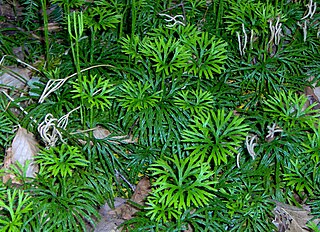
Diphasiastrum digitatum is known as groundcedar, running cedar or crowsfoot, along with other members of its genus, but the common name fan clubmoss can be used to refer to it specifically. It is the most common species of Diphasiastrum in North America. It is a type of plant known as a clubmoss, which is within one of the three main divisions of living vascular plants. It was formerly included in the superspecies Diphasiastrum complanatum. For many years, this species was known as Lycopodium flabelliforme or Lycopodium digitatum.
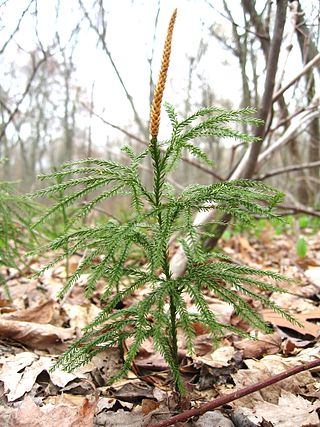
Dendrolycopodium obscurum, synonym Lycopodium obscurum, commonly called rare clubmoss, ground pine, or princess pine, is a North American species of clubmoss in the family Lycopodiaceae. It is a close relative of other species such as D. dendroideum and D. hickeyi, also treelike. It is native to the eastern United States and southeastern Canada from Georgia to Minnesota to Nova Scotia. It grows in the understory of temperate coniferous and deciduous forests, where it is involved in seral secondary succession, growing in clonal colonies some years after disturbance has occurred. It has also been found in Japan, Taiwan, Korea, Russian Far East, and northeastern China.
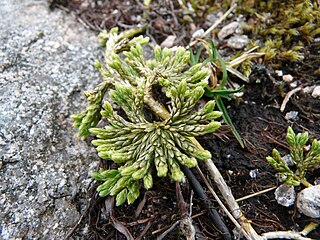
Diphasiastrum alpinum, the alpine clubmoss, is a species of clubmoss. It was first described by Carl Linnaeus in his Flora Lapponica, 1737, from specimens obtained in Finland.
Selaginella stellata, also recognized by its common name, starry spikemoss or starry spike-moss, is a species of spikemoss of the family Selaginellaceae. It is a type of lycopod that grows naturally in Mexico and Central American countries like Guatemala and Belize and can also be found in the state of Hawaii.

Lycopodioideae is a subfamily in the family Lycopodiaceae in the Pteridophyte Phylogeny Group classification of 2016. It is equivalent to a broad circumscription of the genus Lycopodium in other classifications. Like all lycophytes, members of the Lycopodioideae reproduce by spores. The oldest fossils of modern members of the subfamily date to the Early Cretaceous.
Kowieria is an extinct genus of lycopsid from the Late Devonian from Waterloo Farm, containing the single species Kowieria alveoformis. As of 2021 it is being characterised as incertae sedis. It was first described in 2017 from a black shale layer interbedded with quartzite strata of the Famennian aged Witpoort Formation.

Selaginella ciliaris is a plant in the family Selaginellaceae which is native to areas from India and Nepal eastwards to China and Taiwan, and south to northern Australia.

















